Growing up in Pilar, Bataan, a small coastal town in the Philippines, talaba (oysters) wasn't just food, it was an adventure waiting to happen. As kids, my friends and I would walk through the bakawan (mangrove trees) during low tide, carefully plucking fresh oysters while trying not to scratch ourselves on their sharp shells. Those sun-soaked mornings taught me the true meaning of "fresh from the sea to the table."
Years later, this Adobong Talaba recipe still brings back memories of my Nanay's kitchen, where she'd transform our prized catch into this mouthwatering dish that had everyone fighting over the last drop of sauce on their plates. The secret lies in letting the oysters' natural sweetness shine while the garlic-infused adobo sauce adds just the right touch of Filipino home-cooking magic.
I created this adobong talaba recipe to capture those cherished flavors of my childhood. And believe me, whether you get your oysters from the market or from local bakawan like we used to, this 25-minute talaba recipe will transport you straight to a Filipino seaside kitchen.
The combination of briny oysters, tangy calamansi and that perfect garlicky adobo sauce creates something so irresistibly Filipino that you'll want to cook extra rice just for the sauce, trust me on this!
Jump to:
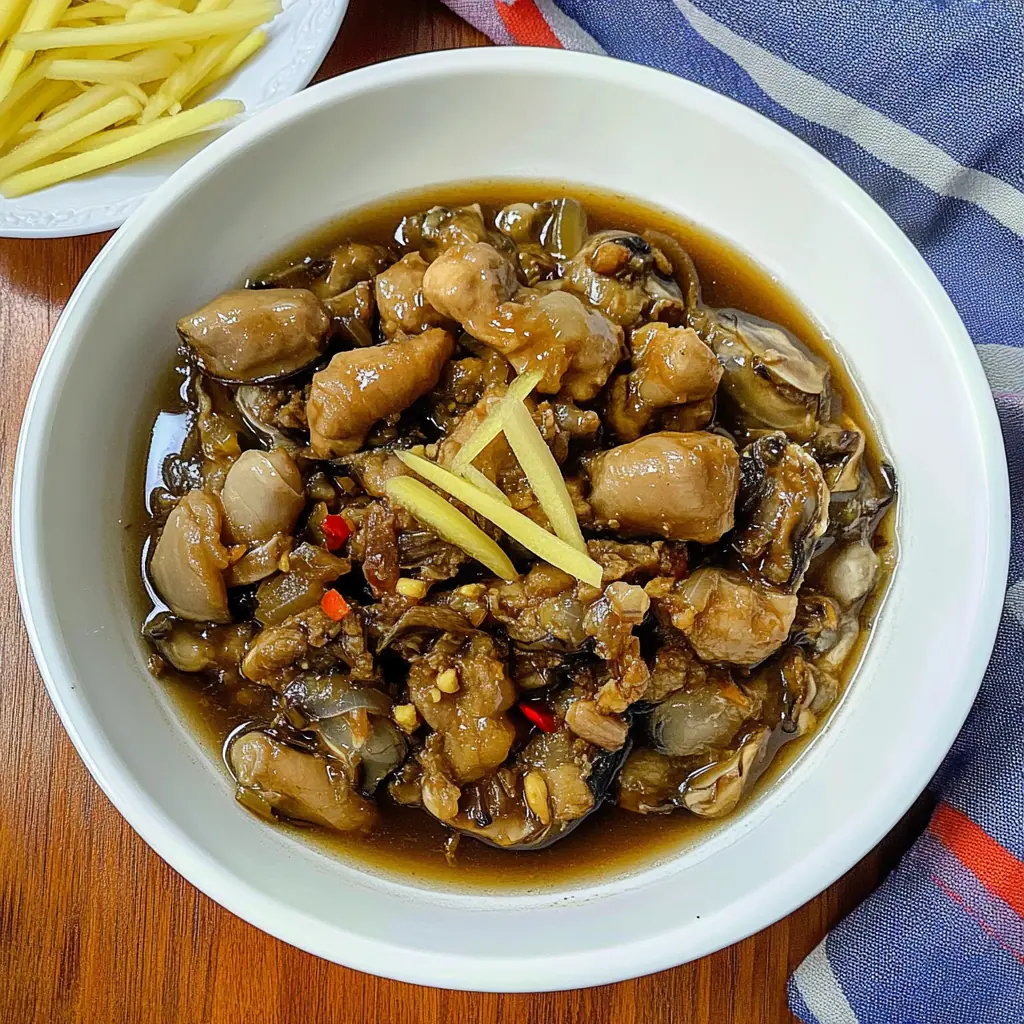
Why You'll Love This Recipe
- Quick & Luxurious: Creates a restaurant-quality dish in just 25 minutes
- Perfectly Balanced: The natural sweetness of oysters meets the savory-tangy adobo sauce
- Versatile: Works as both pulutan (appetizer) or ulam (main dish)
- Authentic Taste: Uses traditional Filipino ingredients and techniques
- Forgiving: Easy to adjust seasonings to your taste
- Impressive: Perfect for both casual family dinners and special occasions
Ingredients
Each ingredient in this Adobong Talaba plays an important role in creating its signature flavor. Fresh oysters provide a natural sweetness and oceanic taste that forms the dish's foundation.
Butter and oil create a rich base, while onions, garlic, and ginger form the aromatic trinity of Filipino cooking. The soy sauce delivers umami depth and signature adobo flavor, while calamansi juice adds the essential tangy brightness that balances the dish.
Black pepper provides gentle heat, and the optional Thai chilies allow you to customize spiciness to your preference. Together, these ingredients create the perfect balance of savory, tangy, and sweet flavors that make this coastal dish so irresistible.
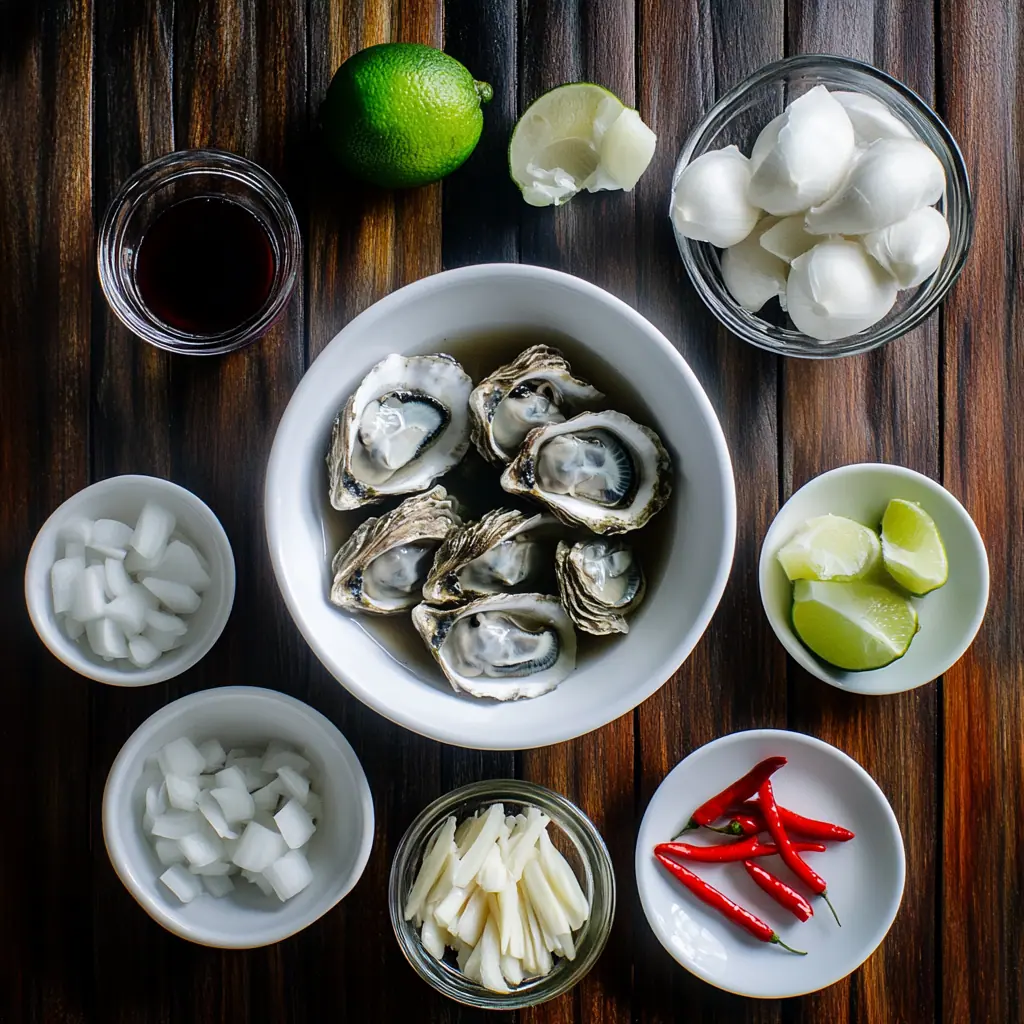
- 2 pounds fresh oysters (meat only, thoroughly drained)
- 1 tablespoon canola oil
- 2 tablespoons butter
- 1 medium onion, finely chopped
- 4 cloves garlic, minced
- 2 thumb-sized ginger, julienned
- ¼ cup soy sauce
- ¼ cup calamansi juice
- Freshly ground black pepper
- Salt to taste
- Optional: 2-3 Thai chili peppers, sliced
Equipment
- Heavy-Bottom Pan or Wok: Ensures even heat distribution, preventing hot spots that could overcook delicate oysters
- Sharp Knife: For precisely mincing garlic, julienning ginger, and chopping onions
- Wooden Spoon or Silicone Spatula: Gentle on oysters while stirring to prevent breaking them
- Small Bowls: For prepping and organizing ingredients before cooking
- Measuring Spoons and Cups: Ensures proper ratios of soy sauce and calamansi juice
- Strainer: Helpful for thoroughly draining excess liquid from oysters
- Paper Towels: Essential for patting oysters dry before cooking
- Serving Dish: Preferably a shallow bowl to showcase the beautiful sauce
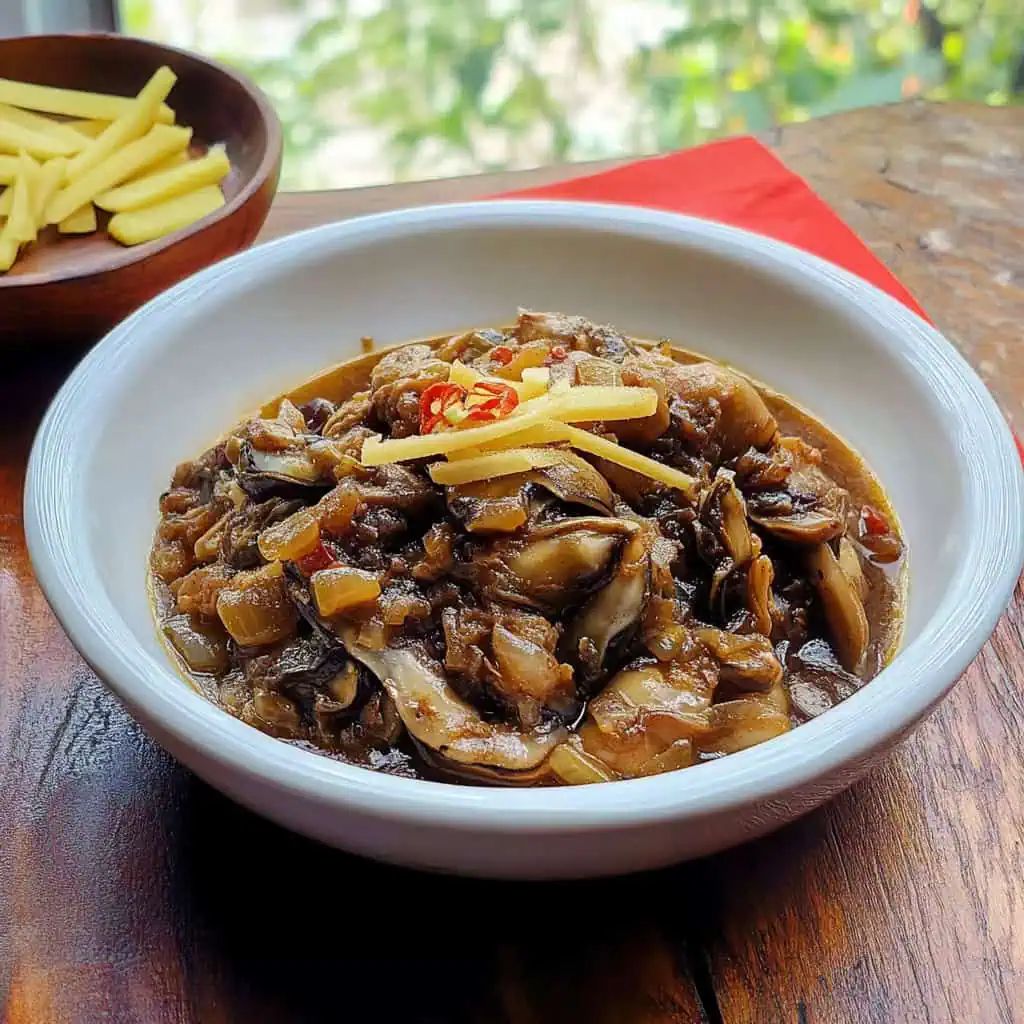
How To Make
- First, clean your fresh oysters thoroughly under running water. Pat them completely dry using paper towels. Let them reach room temperature (27°C/80°F) if they were refrigerated. This ensures even cooking.
- Prepare all your ingredients before starting: finely chop the onion, mince the garlic, and julienne the ginger. Having everything ready makes the cooking process smooth and prevents overcooking.
- Set your stove to medium heat (180°C/350°F). Place your heavy-bottom pan or kawali over the heat. Pour the canola oil and wait for it to become hot but not smoking. Add the butter and allow it to melt completely, swirling the pan to combine with the oil.
- Once the butter has melted, add your chopped onions to the pan. Cook them for 2-3 minutes, stirring occasionally, until they become translucent. You don't want them to brown, just to soften and become fragrant.
- Add the minced garlic and julienned ginger to the pan. Cook for one minute, stirring constantly to prevent burning. The garlic should become fragrant but not brown.
- Gently add your cleaned oysters to the pan. Sauté them carefully for one minute, moving them around the pan with a gentle hand. Remember that oysters are delicate and don't need much cooking.
- Pour in your Filipino soy sauce. Add the black pepper and Thai chilies if using. Cook for another minute, gently stirring to coat the oysters with the sauce.
- Lower the heat to medium-low (160°C/320°F). Pour in the calamansi juice. Let everything simmer gently for 2-3 minutes until the sauce reduces slightly. Avoid stirring too much at this point to keep the oysters tender.
- Taste your sauce and adjust the seasoning with salt if needed. Remember that soy sauce is already salty, so add salt carefully.
- Turn off the heat once the sauce has slightly thickened and the oysters are just cooked through. They should be plump and tender, not shrunken or rubbery.
- Serve your Adobong Talaba immediately while hot over steaming white rice. For the best experience, have some patis (fish sauce) on the side and garnish with fresh calamansi halves if available.

Tips from Lola's Kitchen
- Choose oysters that smell fresh like the sea - If they smell fishy, they're not fresh. Fresh oysters should have a clean, briny aroma that reminds you of ocean water.
- Never overcook oysters - They become tough and rubbery when overcooked. They need just enough heat to warm through and absorb the flavors.
- Use Filipino soy sauce for authentic taste - Filipino soy sauce (like Datu Puti or Silver Swan) has a different flavor profile than Chinese or Japanese varieties, with a unique balance of saltiness and subtle sweetness.
- If possible, use fresh calamansi for the best flavor - The unique citrus note of calamansi can't be perfectly replicated. The freshly squeezed juice adds bright acidity that balances the dish.
- Pat oysters very dry - This is crucial for achieving better caramelization and preventing the sauce from becoming too watery.
- Don't move the oysters too much while cooking - Excessive stirring can break them apart. Gentle, occasional stirring is best.
- Keep the heat medium to prevent the garlic from burning - Burnt garlic will ruin the entire dish with a bitter taste that's impossible to fix.
- Let ingredients reach room temperature before cooking - This promotes even cooking and better flavor development.
Substitutions
- Calamansi juice: Replace with a 3:1 mixture of lime juice and orange juice, or use lemon juice with a tiny pinch of sugar (1:1 ratio)
- Fresh oysters: Frozen oysters (thawed and drained well) work in a pinch, but reduce cooking time slightly
- Canola oil: Any neutral cooking oil like vegetable oil, grapeseed oil, or avocado oil
- Thai chilies: Red pepper flakes (¼ teaspoon per chili), jalapeño, or serrano peppers
- Fresh ginger: Ginger paste (1 tablespoon) or 1 teaspoon ground ginger
- Filipino soy sauce: Regular soy sauce mixed with 1 teaspoon of brown sugar per ¼ cup
- Butter: Margarine or additional oil for dairy-free option, though the richness will be slightly different
Troubleshooting
Watery Sauce?
- Drain oysters more thoroughly before cooking
- Extend cooking time by 2-3 minutes to reduce sauce further
- Add a small cornstarch slurry (½ teaspoon cornstarch mixed with 1 tablespoon water)
- Use less calamansi juice initially
Tough Oysters?
- Reduce cooking time - oysters need minimal cooking
- Lower heat slightly throughout the cooking process
- Add oysters later in the cooking process after the sauce has reduced a bit
- Make sure not to overcook when reheating
Too Salty?
- Use less soy sauce next time, starting with just 2-3 tablespoons
- Balance with more calamansi juice or a small amount of sugar (¼ teaspoon)
- Add a touch more butter to round out the flavors
- Serve with plain rice to balance the saltiness
Bitter Taste?
- Garlic may have burned - next time, cook garlic on lower heat
- Add a tiny pinch of sugar (⅛ teaspoon) to balance bitterness
- Some ginger can be bitter - use younger, fresher ginger next time
Storage & Reheating
Refrigerator:
- Store in an airtight container for up to 3 days
- Keep sauce separate from oysters if possible to prevent them from becoming tough
Freezer:
- Not recommended for cooked oysters as texture significantly deteriorates
Reheating:
- Stovetop (Preferred Method): Warm gently over low heat just until the sauce and oysters reach 165°F. Add a splash of water if sauce has thickened too much.
- Microwave: Heat in 30-second intervals at 50% power, stirring between each interval. Stop as soon as it's warmed through to prevent overcooking.
- For best results, only reheat once, as multiple reheating cycles will toughen the oysters.
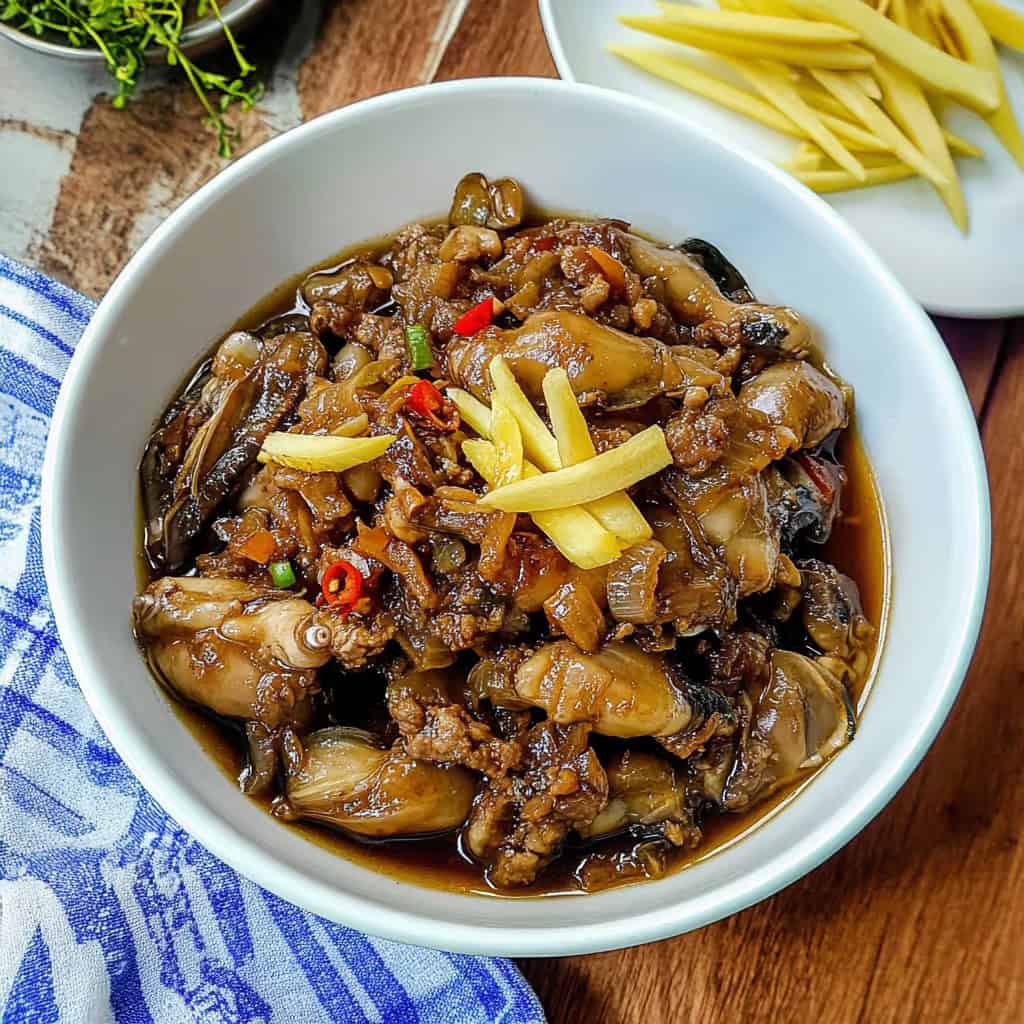
FAQ
How do I know if oysters are fresh?
Fresh oysters should smell like the sea, not fishy. If buying in shells, they should be tightly closed or close when tapped. The meat should look plump and moist with a creamy color, not dried out or discolored.
Can I make this ahead for a party?
While best served fresh, you can prepare it up to 3 hours ahead and keep at room temperature. For longer storage (up to 3 days), refrigerate and reheat gently to prevent overcooking the oysters. Consider slightly undercooking initially if you plan to reheat.
Is this dish spicy?
The basic recipe is not spicy, but you can customize the heat level by adding Thai chilies to taste. Start with one chili and adjust according to your preference.
Can I use bottled calamansi juice?
Yes, though fresh is preferred for brightness. Use the same amount, but taste and adjust as bottled versions can vary in acidity and sweetness.
What's the best pan to use?
A heavy-bottom pan or wok works best for even heat distribution. Cast iron, stainless steel, or a traditional kawali (Filipino wok) are excellent choices.
Can I add vegetables to this dish?
Yes! Bell peppers, snow peas, or asparagus make great additions. Add them after the oysters and cook briefly to maintain crispness.
How can I tell when the oysters are perfectly cooked?
Perfectly cooked oysters will be plump with slightly curled edges. They should be opaque but still juicy, not shrunken or rubbery. This typically happens within 2-3 minutes of gentle cooking.
What can I serve with Adobong Talaba?
Besides steamed rice, it pairs wonderfully with garlic fried rice (sinangag), a simple green salad, or pickled papaya (atchara) for a complete meal.
Related
Looking for other recipes like this? Try these:
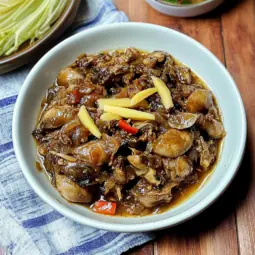
Adobong Talaba (Filipino Oyster Adobo)
Ingredients
- 2 pounds fresh oysters meat only, thoroughly drained
- 1 tablespoon canola oil
- 2 tablespoons butter
- 1 medium onion finely chopped
- 4 cloves garlic minced
- 2 thumb-sized ginger julienned
- ¼ cup soy sauce
- ¼ cup calamansi juice
- Freshly ground black pepper
- Salt to taste
- Optional: 2-3 Thai chili peppers sliced
Instructions
- First, clean your fresh oysters (talaba) thoroughly under running water. Pat them completely dry using paper towels (tuyuin ng mabuti gamit ang paper towel). Let them reach room temperature (27°C/80°F) if they were refrigerated. This ensures even cooking (para pantay ang pagkakaluto).
- Prepare all your ingredients before starting: finely chop the onion (tadtarin ang sibuyas), mince the garlic (dikdikin ang bawang), and julienne the ginger (hiwain ng pahaba ang luya). Having everything ready makes the cooking process smooth and prevents overcooking (para hindi lumambot masyado ang talaba).
- Set your stove to medium heat (katamtamang init or 180°C/350°F). Place your heavy-bottom pan or kawali over the heat. Pour the canola oil and wait for it to become hot but not smoking. Add the butter and allow it to melt completely, swirling the pan to combine with the oil.
- Once the butter has melted, add your chopped onions to the pan. Cook them for 2-3 minutes, stirring occasionally, until they become translucent. You don't want them to brown, just to soften and become fragrant.
- Add the minced garlic and julienned ginger to the pan. Cook for one minute, stirring constantly to prevent burning (haluin palagi para hindi masunog). The garlic should become fragrant but not brown (mabango pero hindi kulay brown ang bawang).
- Gently add your cleaned oysters to the pan. Sauté them carefully for one minute, moving them around the pan with a gentle hand (igisa ng marahan). Remember that oysters are delicate and don't need much cooking.
- Pour in your Filipino soy sauce or toyo. Add the black pepper (paminta) and Thai chilies if using. Cook for another minute, gently stirring to coat the oysters with the sauce (haluing mabuti para mabalutan ng sarsa ang talaba).
- Lower the heat to medium-low (hinaan ang apoy or 160°C/320°F). Pour in the calamansi juice. Let everything simmer gently for 2-3 minutes until the sauce reduces slightly (pakuluan hanggang lumapot ng kaunti ang sarsa). Avoid stirring too much at this point to keep the oysters tender.
- Taste your sauce and adjust the seasoning with salt (asin) if needed. Remember that soy sauce is already salty, so add salt carefully (mag-ingat sa paglalagay ng asin dahil maalat na ang toyo).
- Turn off the heat once the sauce has slightly thickened and the oysters are just cooked through. They should be plump and tender, not shrunken or rubbery (dapat malaman at malambot ang talaba, hindi kumukulubot o matigas).
- Serve your Adobong Talaba immediately while hot (ihain habang mainit pa) over steaming white rice (mainit na kanin). For the best experience, have some patis (fish sauce) on the side and garnish with fresh calamansi halves if available.
- If you need to store leftovers, let them cool to room temperature first, then place in an airtight container. Keep in the refrigerator for up to three days. When reheating, do so gently over medium-low heat (160°C/320°F) just until warmed through to prevent the oysters from becoming tough (initin ng marahan para hindi matigas ang talaba).
Tips from Lola's Kitchen
- Choose oysters that smell fresh like the sea
- Never overcook oysters as they become tough and rubbery
- Use Filipino soy sauce for authentic taste
- If possible, use fresh calamansi for the best flavor
- Pat oysters very dry to achieve better caramelization
- Don't move the oysters too much while cooking
- Keep the heat medium to prevent the garlic from burning
Nutrition
The Story Behind Adobong Talaba (Filipino Oyster Adobo)
Growing up in coastal Philippines, I learned that the best recipes are born where the land meets the sea. Adobong Talaba, a treasured variation of our national dish adobo, showcases how coastal communities brilliantly adapted the classic cooking method to celebrate the bounty of their waters. While the origins of traditional pork and chicken adobo trace back to Spanish colonial times, this seafood version tells a different story - one of resourceful fishermen and creative home cooks who saw the potential in marrying fresh oysters with adobo's signature sauce.
In many coastal regions, especially in provinces like Cavite, Aklan, and Capiz (our country's seafood capitals), Adobong Talaba emerged as a practical way to elevate the abundant oyster harvest. Local families discovered that the briny sweetness of fresh talaba paired beautifully with adobo's garlicky-tangy profile. Unlike its meat counterparts that simmer for hours, this seafood adaptation celebrates the delicate texture of oysters through a quicker cooking process that preserves their natural oceanic flavor while infusing them with that distinctive adobo taste we Filipinos love.
What makes this dish truly special is how it reflects our maritime heritage. In many coastal barrios, gathering talaba from mangrove areas isn't just about food - it's a community activity that brings neighbors together during low tide. The recipe itself varies slightly from region to region: some families add ginger for extra warmth, others swear by adding coconut milk, while some coastal communities include lemongrass for a citrusy note. But the heart of the dish remains the same: fresh oysters transformed by the perfect balance of Filipino soy sauce, calamansi, and garlic.
Today, Adobong Talaba stands as a testament to Filipino culinary innovation. Whether served as pulutan during beachside gatherings or as a special Sunday lunch ulam, this dish continues to tell the story of our coastal communities. It's more than just another adobo variation - it's a celebration of our connection to the sea, our love for bold flavors, and our talent for making something extraordinary from the simplest ingredients nature provides.
When cooked properly, each spoonful captures that perfect moment where traditional adobo meets the fresh flavors of the sea, creating what many consider to be the ultimate Filipino seafood comfort food. From humble seaside kitchens to modern Filipino restaurants worldwide, Adobong Talaba continues to earn its place as one of our cuisine's most beloved seafood preparations.
Remember: Perfect adobong talaba isn't just about the sauce—it's about achieving that ideal point where the oysters are just cooked through, maintaining their oceanic sweetness while soaking up the tangy adobo sauce without becoming rubbery.
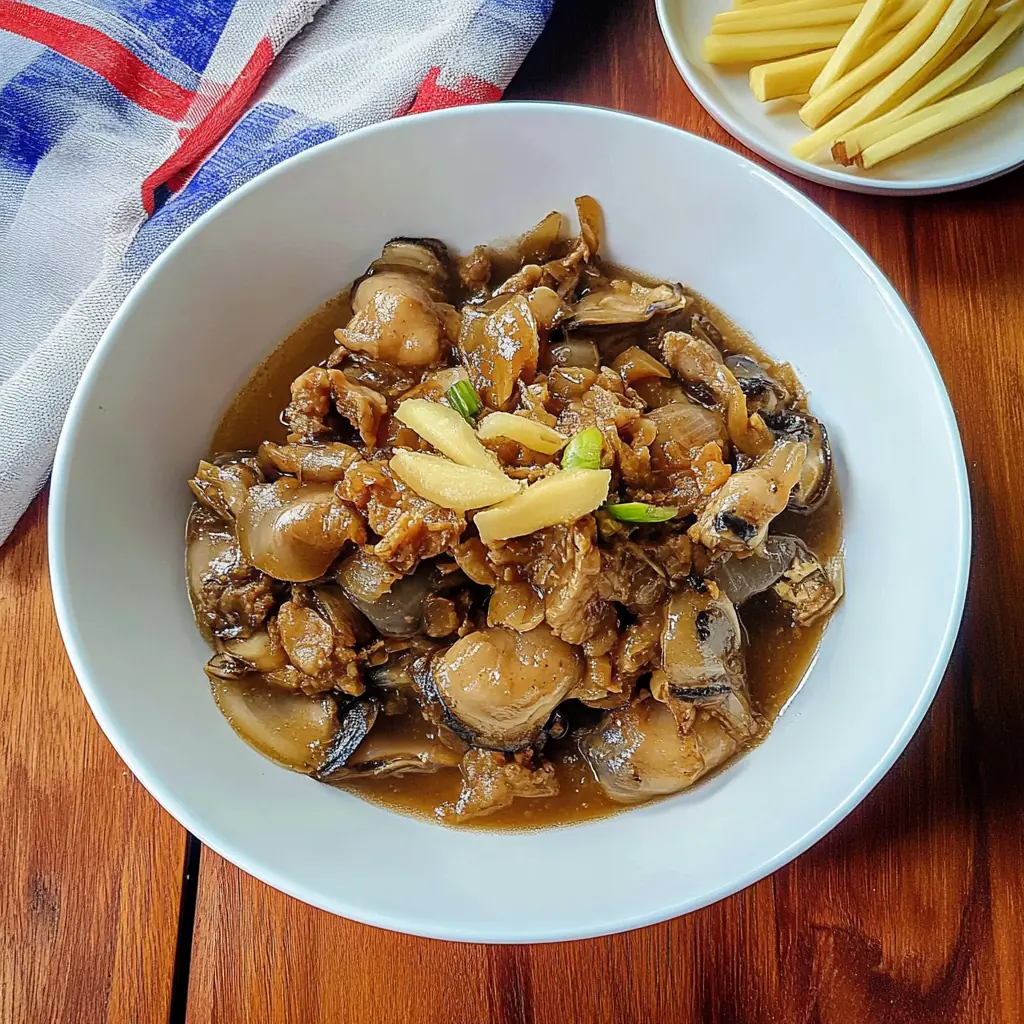









Comments
No Comments